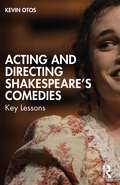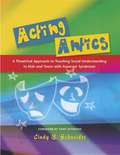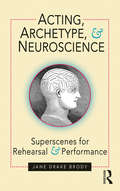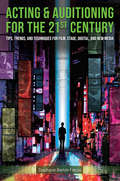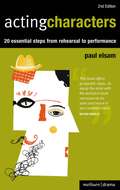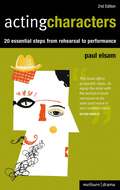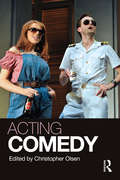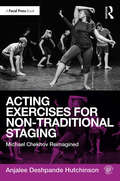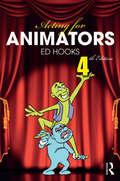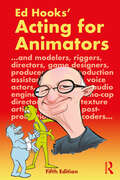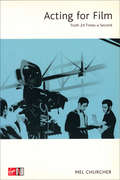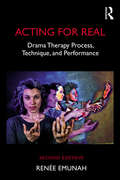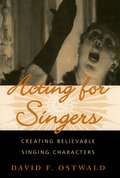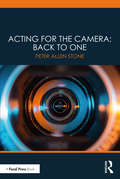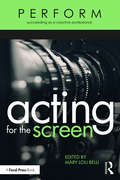- Table View
- List View
Acting and Directing Shakespeare's Comedies: Key Lessons
by Kevin OtosActing and Directing Shakespeare’s Comedies: Key Lessons outlines a clear, effective process for acting Shakespeare’s comedies. This book lays out core principles and useful exercises that help the reader better understand, expereince, and implement Shakespeare's comedic design. Building off of modern acting methods as well as contemporary Clown, classical Commedia, and verse-speaking techniques, the author guides the reader toward interpretive and performance choices that are original, justified, and entertaining. Included are clear examples and detailed case studies that illuminate and reenforce these key lessons. This accessible book is for actors, directors, students of Shakespeare, and those who want a fuller, richer awareness of the possibilities within Shakespeare’s comedies and a clear, pragmatic process for creating those performances.
Acting and Directing Shakespeare's Comedies: Key Lessons
by Kevin OtosActing and Directing Shakespeare’s Comedies: Key Lessons outlines a clear, effective process for acting Shakespeare’s comedies. This book lays out core principles and useful exercises that help the reader better understand, expereince, and implement Shakespeare's comedic design. Building off of modern acting methods as well as contemporary Clown, classical Commedia, and verse-speaking techniques, the author guides the reader toward interpretive and performance choices that are original, justified, and entertaining. Included are clear examples and detailed case studies that illuminate and reenforce these key lessons. This accessible book is for actors, directors, students of Shakespeare, and those who want a fuller, richer awareness of the possibilities within Shakespeare’s comedies and a clear, pragmatic process for creating those performances.
Acting Antics: A Theatrical Approach to Teaching Social Understanding to Kids and Teens with Asperger Syndrome (PDF)
by Cindy Schneider Tony Attwood`The ideas are excellent and well laid out… This is an innovative approach to social skills training for students with Asperger's Syndrome who will tolerate acting, and for a group leader with energy and commitment to drama.' -Speech and Language Therapy in Practice `Schneider's enthusiasm for the subject and her passion to improve life skills of young people is very evident and encourages the reader to progress…As a catalogue of practical ideas with built-in resources, this is a useful book for support groups and families wishing to create a theatre group. Acting Antics has an easy-to-read format and includes activities that can be initiated with minimum preparation and resources.' -Children Now Magazine, 2007 This fun and inspiring step-by-step program provides the full set of tools for developing social understanding in children with Asperger Syndrome (AS) through drama. Cindy B. Schneider explains how the central processes in acting - including making and interpreting inferences from non-verbal cues, taking another's perspective, and formulating language - can be highly effective ways of addressing social cognition deficits in children with AS. Acting Antics contains a wide repertoire of activities and ideas for immediate application at home, in the classroom, in therapy workshops or social groups, ranging from initial warm up techniques, through paired activities, to larger group scenes and staging a show. Helpful appendices provide questionnaire forms to enable both the child and the program leader to assess and monitor the child's understanding of their roles, along with reproducible scripts and suitable scene designs. This complete, practical program provides a wealth of enjoyable educational ideas for parents, teachers, and therapists of children with Asperger Syndrome.
Acting, Archetype, and Neuroscience: Superscenes for Rehearsal and Performance
by Jane Drake Brody"How do we move actors into the less accessible regions of themselves and release hotter, more dangerous, and less literal means of approaching a role?" Superscenes are a revolutionary new mode of teaching and rehearsal, allowing the actor to discover and utilize the primal energies underlying dramatic texts. In Acting, Archetype, and Neuroscience Jane Drake Brody draws upon a lifetime’s experience in the theatre, alongside the best insights into pedagogical practice in the field, the work of philosophers and writers who have focused on myth and archetype, and the latest insights of neuroscience. The resulting interdisciplinary, exciting volume works to: Mine the essentials of accepted acting theory while finding ways to access more primally-based human behavior in actors Restore a focus on storytelling that has been lost in the rush to create complex characters with arresting physical and vocal lives Uncover the mythical bones buried within every piece of dramatic writing; the skeletal framework upon which hangs the language and drama of the play itself Focus on the actor’s body as the only place where the conflict inherent in drama can be animated. Acting, Archetype, and Neuroscience weaves together a wealth of seemingly disparate performance methods, exciting actors to imaginatively and playfully take risks they might otherwise avoid. A radical new mixture of theory and practice by a highly respected teacher of acting, this volume is a must-read for students and performance practitioners alike.
Acting, Archetype, and Neuroscience: Superscenes for Rehearsal and Performance
by Jane Drake Brody"How do we move actors into the less accessible regions of themselves and release hotter, more dangerous, and less literal means of approaching a role?" Superscenes are a revolutionary new mode of teaching and rehearsal, allowing the actor to discover and utilize the primal energies underlying dramatic texts. In Acting, Archetype, and Neuroscience Jane Drake Brody draws upon a lifetime’s experience in the theatre, alongside the best insights into pedagogical practice in the field, the work of philosophers and writers who have focused on myth and archetype, and the latest insights of neuroscience. The resulting interdisciplinary, exciting volume works to: Mine the essentials of accepted acting theory while finding ways to access more primally-based human behavior in actors Restore a focus on storytelling that has been lost in the rush to create complex characters with arresting physical and vocal lives Uncover the mythical bones buried within every piece of dramatic writing; the skeletal framework upon which hangs the language and drama of the play itself Focus on the actor’s body as the only place where the conflict inherent in drama can be animated. Acting, Archetype, and Neuroscience weaves together a wealth of seemingly disparate performance methods, exciting actors to imaginatively and playfully take risks they might otherwise avoid. A radical new mixture of theory and practice by a highly respected teacher of acting, this volume is a must-read for students and performance practitioners alike.
Acting & Auditioning for the 21st Century: Tips, Trends, and Techniques for Digital and New Media
by Stephanie Barton-FarcasActing & Auditioning for the 21st Century covers acting and auditioning in relation to new media, blue and green screen technology, motion capture, web series, audiobook work, evolving livestreamed web series, and international acting and audio work. Readers are given a methodology for changing artistic technology and the global acting market, with chapters covering auditions of all kinds, contracts, the impact of new technology and issues relating to disabled actors, actors of colour and actors that are part of the LGBTQIA community.
Acting & Auditioning for the 21st Century: Tips, Trends, and Techniques for Digital and New Media
by Stephanie Barton-FarcasActing & Auditioning for the 21st Century covers acting and auditioning in relation to new media, blue and green screen technology, motion capture, web series, audiobook work, evolving livestreamed web series, and international acting and audio work. Readers are given a methodology for changing artistic technology and the global acting market, with chapters covering auditions of all kinds, contracts, the impact of new technology and issues relating to disabled actors, actors of colour and actors that are part of the LGBTQIA community.
Acting Characters: 20 simple steps from rehearsal to performance (Performance Books)
by Paul ElsamRecently selected as an Edexcel set text, Paul Elsam's Acting Characters is an introductory handbook for the aspiring actor, compiled of twenty steps grouped into six sections to help create, present and sustain a believable character in most circumstances. It is fundamentally practical and avoids heavy discussion of theory, looking instead at how to use different voices and body language to convey character. According to a peer reviewer, the book is "both interesting for the casual enquirer and illuminating for the more serious practitioner". It de-mystifies the fundamental concepts of Stanislavski's teaching in an accessible way and it is this clarity and empathy with its readership that sets this book apart from its main competition, which the author describes as containing "a lot of rather mystical ideas on how actors go about their craft, but very little on the actual moment-by-moment skills you can work on".
Acting Characters: 20 simple steps from rehearsal to performance (Performance Books)
by Paul ElsamRecently selected as an Edexcel set text, Paul Elsam's Acting Characters is an introductory handbook for the aspiring actor, compiled of twenty steps grouped into six sections to help create, present and sustain a believable character in most circumstances. It is fundamentally practical and avoids heavy discussion of theory, looking instead at how to use different voices and body language to convey character. According to a peer reviewer, the book is "both interesting for the casual enquirer and illuminating for the more serious practitioner". It de-mystifies the fundamental concepts of Stanislavski's teaching in an accessible way and it is this clarity and empathy with its readership that sets this book apart from its main competition, which the author describes as containing "a lot of rather mystical ideas on how actors go about their craft, but very little on the actual moment-by-moment skills you can work on".
Acting Comedy
by Christopher OlsenDespite being roundly cited as much harder to perform than its dramatic counterpart, comic acting is traditionally seen as a performance genre that can’t be taught. At best it is often described as a skill that can only be learned "on the job" through years of practice, or given to a performer through natural talent. Acting Comedy is an effort to examine this idea more rigorously by looking at different aspects of the comic actor’s craft. Each chapter is written by an expert in a particular form—from actors and directors to teachers and standup comedians. Topics covered include: how performers work with audiences how comic texts can be enhanced through word and musical rhythm analysis how physical movements can generate comic moments and build character. This book is an invaluable resource for any performer focusing on the minute details of comic acting, even down to exactly how one delivers a joke on stage. Christopher Olsen’s unique collection of comic voices will prove essential reading for students and professionals alike.
Acting Comedy
by Christopher OlsenDespite being roundly cited as much harder to perform than its dramatic counterpart, comic acting is traditionally seen as a performance genre that can’t be taught. At best it is often described as a skill that can only be learned "on the job" through years of practice, or given to a performer through natural talent. Acting Comedy is an effort to examine this idea more rigorously by looking at different aspects of the comic actor’s craft. Each chapter is written by an expert in a particular form—from actors and directors to teachers and standup comedians. Topics covered include: how performers work with audiences how comic texts can be enhanced through word and musical rhythm analysis how physical movements can generate comic moments and build character. This book is an invaluable resource for any performer focusing on the minute details of comic acting, even down to exactly how one delivers a joke on stage. Christopher Olsen’s unique collection of comic voices will prove essential reading for students and professionals alike.
Acting Exercises for Non-Traditional Staging: Michael Chekhov Reimagined
by Anjalee Deshpande HutchinsonActing Exercises for Non-Traditional Staging: Michael Chekhov Reimagined offers a new set of exercises for coaching actors when working on productions that are non-traditionally staged in arenas, thrusts, or alleys. All of the exercises are adapted from Michael Chekhov's acting technique, but are reimagined in new and creative ways that offer innovative twists for the practitioner familiar with Chekhov, and easy accessibility for the practitioner new to Chekhov. Exploring the methodology through a modern day lens, these exercises are energizing additions to the classroom and essential tools for more a vibrant rehearsal and performance.
Acting Exercises for Non-Traditional Staging: Michael Chekhov Reimagined
by Anjalee Deshpande HutchinsonActing Exercises for Non-Traditional Staging: Michael Chekhov Reimagined offers a new set of exercises for coaching actors when working on productions that are non-traditionally staged in arenas, thrusts, or alleys. All of the exercises are adapted from Michael Chekhov's acting technique, but are reimagined in new and creative ways that offer innovative twists for the practitioner familiar with Chekhov, and easy accessibility for the practitioner new to Chekhov. Exploring the methodology through a modern day lens, these exercises are energizing additions to the classroom and essential tools for more a vibrant rehearsal and performance.
Acting for Animators: 4th Edition
by Ed HooksEd Hooks' essential acting guidebook for animators has been fully revised and updated in this 4th edition. Hooks uses classical acting theory – from Aristotle to Stanislavsky and beyond – to explain everything from character analysis and physical movement to facial expression and scene structure. He speaks directly to animators, instead of stage or screen actors. Acting for Animators is an invaluable primer for beginner animators and a useful reference for experienced pros. New to this fourth edition: - 6 new scene-by-scene acting analyses of animated feature films, including Zootopia and The Little Prince - an annotated analysis of Walt Disney’s famous 1935 memo to Don Graham, regarding how best to train animators - advice to the animator about how best to perform visual references - a chapter on Virtual Reality - an online database of Ed’s previous film analyses, all in one place.
Acting for Animators
by Ed HooksEd Hooks' essential acting guidebook for animators has been fully revised and updated in this fifth edition, capturing some of the vast changes that have affected the animation industry in recent years. Written specifically for animation professionals instead of stage and movie actors, this book provides an essential primer for creating empathetic and dynamic character performance and, in the process, shows how the strongest storytelling structure works. Hooks applies classical acting theory – from Aristotle to Stanislavsky and beyond – to animation, as well as explaining scene structure, character development and the connections between thinking, emotion and physical action. Theory presented here applies to any and all character animation regardless of style or animation technique. Whether your project is stop-motion, 2D, 3D or a blend of techniques, audiences are audiences are audiences, and they have shown up at the theater or cinema so they can experience and enjoy your story. New to this fifth edition: Four new scene-by-scene acting analyses of animated feature films: Flee, Soul, Porco Rosso and The Triplets of Belleville. A comprehensive and updated section titled "Classroom Notes" which includes a segment on experimental animation, a brief history of acting training for actors and guidance on Motion and Performance Capture technology. Updated online database of Hooks' previous film analyses, all in one place. Acting for Animators is essential reading for all students and teachers of animation courses.
Acting for Animators
by Ed HooksEd Hooks' essential acting guidebook for animators has been fully revised and updated in this fifth edition, capturing some of the vast changes that have affected the animation industry in recent years. Written specifically for animation professionals instead of stage and movie actors, this book provides an essential primer for creating empathetic and dynamic character performance and, in the process, shows how the strongest storytelling structure works. Hooks applies classical acting theory – from Aristotle to Stanislavsky and beyond – to animation, as well as explaining scene structure, character development and the connections between thinking, emotion and physical action. Theory presented here applies to any and all character animation regardless of style or animation technique. Whether your project is stop-motion, 2D, 3D or a blend of techniques, audiences are audiences are audiences, and they have shown up at the theater or cinema so they can experience and enjoy your story. New to this fifth edition: Four new scene-by-scene acting analyses of animated feature films: Flee, Soul, Porco Rosso and The Triplets of Belleville. A comprehensive and updated section titled "Classroom Notes" which includes a segment on experimental animation, a brief history of acting training for actors and guidance on Motion and Performance Capture technology. Updated online database of Hooks' previous film analyses, all in one place. Acting for Animators is essential reading for all students and teachers of animation courses.
Acting for Animators (PDF): 4th Edition
by Ed HooksEd Hooks' essential acting guidebook for animators has been fully revised and updated in this 4th edition. Hooks uses classical acting theory – from Aristotle to Stanislavsky and beyond – to explain everything from character analysis and physical movement to facial expression and scene structure. He speaks directly to animators, instead of stage or screen actors. Acting for Animators is an invaluable primer for beginner animators and a useful reference for experienced pros. New to this fourth edition: - 6 new scene-by-scene acting analyses of animated feature films, including Zootopia and The Little Prince - an annotated analysis of Walt Disney’s famous 1935 memo to Don Graham, regarding how best to train animators - advice to the animator about how best to perform visual references - a chapter on Virtual Reality - an online database of Ed’s previous film analyses, all in one place.
Acting For Film: Truth 24 Times A Second
by Mel ChurcherThe author uses her wide experience as an acting and voice coach an major movies to offer insights into the film acting process. She provides tasks, techniques and tips that are designed specifically for film: there's advice to make the first-time film actor feel at home on set, tips on the casting process, how to cope with auditions, on-camera techniques, schedules and shooting order, as well as specific advice from film crews to help an actor's performance. This practical workbook combines exercises and anecdotes in an informal and accessible style, making it the indispensable guide for anyone wishing to light up the silver screen.
Acting For Real: Drama Therapy Process, Technique, And Performance
by Renée EmunahThis second edition takes the reader further into the heart of using drama for healing. Dr. Emunah offers an expanded understanding of her Integrative Five Phase model, a foundational approach that embraces the wide spectrum of possibilities within the playing field of drama therapy. Grounded by compassionate clinical examples, including ones that reach over time into deep-seated issues, the book offers tools for action-oriented treatment, embodied therapeutic interventions, and creatively engaging a wide variety of clients. This comprehensive text also contains over 120 techniques, categorized by phases in the session and treatment series, and subcategorized by therapeutic objective. Process-oriented drama therapy with group and individuals, as well as performance-oriented forms, are described in vivid detail. New to the second edition is an exploration of drama therapy outside of the clinical arena, including dramatic methods in family life and parenting, and drama therapy geared toward social change.
Acting For Real: Drama Therapy Process, Technique, And Performance
by Renée EmunahThis second edition takes the reader further into the heart of using drama for healing. Dr. Emunah offers an expanded understanding of her Integrative Five Phase model, a foundational approach that embraces the wide spectrum of possibilities within the playing field of drama therapy. Grounded by compassionate clinical examples, including ones that reach over time into deep-seated issues, the book offers tools for action-oriented treatment, embodied therapeutic interventions, and creatively engaging a wide variety of clients. This comprehensive text also contains over 120 techniques, categorized by phases in the session and treatment series, and subcategorized by therapeutic objective. Process-oriented drama therapy with group and individuals, as well as performance-oriented forms, are described in vivid detail. New to the second edition is an exploration of drama therapy outside of the clinical arena, including dramatic methods in family life and parenting, and drama therapy geared toward social change.
Acting for Singers: Creating Believable Singing Characters
by David F. OstwaldWritten to meet the needs of thousands of students and pre-professional singers participating in production workshops and classes in opera and musical theater, Acting for Singers leads singing performers step by step from the studio or classroom through audition and rehearsals to a successful performance. Using a clear, systematic, positive approach, this practical guide explains how to analyze a script or libretto, shows how to develop a character building on material in the score, and gives the singing performer the tools to act believably. More than just a "how-to" acting book, however, Acting for Singers also addresses the problems of concentration, trust, projection, communication, and the self-doubt that often afflicts singers pursuing the goal of believable performance. Part I establishes the basic principles of acting and singing together, and teaches the reader how to improvise as a key tool to explore and develop characters. Part II teaches the singer how to analyze theatrical work for rehearsing and performing. Using concrete examples from Carmen and West Side Story, and imaginative exercises following each chapter, this text teaches all singers how to be effective singing actors.
Acting for Singers: Creating Believable Singing Characters
by David F. OstwaldWritten to meet the needs of thousands of students and pre-professional singers participating in production workshops and classes in opera and musical theater, Acting for Singers leads singing performers step by step from the studio or classroom through audition and rehearsals to a successful performance. Using a clear, systematic, positive approach, this practical guide explains how to analyze a script or libretto, shows how to develop a character building on material in the score, and gives the singing performer the tools to act believably. More than just a "how-to" acting book, however, Acting for Singers also addresses the problems of concentration, trust, projection, communication, and the self-doubt that often afflicts singers pursuing the goal of believable performance. Part I establishes the basic principles of acting and singing together, and teaches the reader how to improvise as a key tool to explore and develop characters. Part II teaches the singer how to analyze theatrical work for rehearsing and performing. Using concrete examples from Carmen and West Side Story, and imaginative exercises following each chapter, this text teaches all singers how to be effective singing actors.
Acting for the Camera: Back to One
by Peter Allen StoneActing for the Camera: Back to One is a "how to" book with practical steps to achieve a professional performance on camera. The book focuses on four distinct areas: how to prepare the character, how to execute the technical responsibilities that will assist the editor in creating the on-camera performance in post-production, tips from industry professionals, and how to create effective self-tape auditions. Part One: The Character’s World is packed with tools to analyze the script and fully prepare the character before arriving on set. Part Two: The Actor’s World focuses on developing technical acting skills for the camera that assist the pre- and post-production teams to create a dynamic on-screen performance. In Part Three: The Professional World, industry professionals provide tips from inside the film/TV audition room and how to navigate a career in the acting business. The final section, Part Four: Self-Tape Like a Pro, outlines how to build a self-tape studio in the privacy of your own home and submit high-quality self-tape auditions that will help you stand out from the competition. Written for students enrolled in Acting for the Camera courses, Acting for the Camera: Back to One explores techniques that can be practiced and mastered by actors of all levels, from the moment they audition for the part through to when they hear that director call "cut!"
Acting for the Camera: Back to One
by Peter Allen StoneActing for the Camera: Back to One is a "how to" book with practical steps to achieve a professional performance on camera. The book focuses on four distinct areas: how to prepare the character, how to execute the technical responsibilities that will assist the editor in creating the on-camera performance in post-production, tips from industry professionals, and how to create effective self-tape auditions. Part One: The Character’s World is packed with tools to analyze the script and fully prepare the character before arriving on set. Part Two: The Actor’s World focuses on developing technical acting skills for the camera that assist the pre- and post-production teams to create a dynamic on-screen performance. In Part Three: The Professional World, industry professionals provide tips from inside the film/TV audition room and how to navigate a career in the acting business. The final section, Part Four: Self-Tape Like a Pro, outlines how to build a self-tape studio in the privacy of your own home and submit high-quality self-tape auditions that will help you stand out from the competition. Written for students enrolled in Acting for the Camera courses, Acting for the Camera: Back to One explores techniques that can be practiced and mastered by actors of all levels, from the moment they audition for the part through to when they hear that director call "cut!"
Acting for the Screen (PERFORM)
by Mary Lou BelliActing for the Screen is a collection of essays written by and interviews with working actors, producers, directors, casting directors, and acting professors, exploring the business side of screen acting. In this book, over thirty show business professionals dispel myths about the industry and provide practical advice on topics such as how to break into the field, how to develop, nurture, and navigate business relationships, and how to do creative work under pressure. Readers will also learn about the entrepreneurial expectations in relation to the internet and social media, strategies for contending with the emotional highs and lows of acting, and money management while pursuing acting as a profession. Written for undergraduates and graduates studying Acting for Screen, aspiring professional actors, and working actors looking to reinvent themselves, Acting for the Screen provides readers with a wealth of first-hand information that will help them create their own opportunities and pursue a career in show business.
